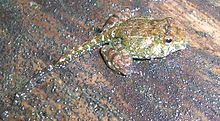Indirana
| Indirana | |
|---|---|

| |
| Adult Indirana semipalmata | |
| Scientific classification | |
| Domain: | Eukaryota |
| Kingdom: | Animalia |
| Phylum: | Chordata |
| Class: | Amphibia |
| Order: | Anura |
| Subfamily: | Ranixalinae |
| Genus: | Indirana Laurent, 1986 |
| Type species | |
| Polypedates beddomii Günther, 1876
| |
| Diversity | |
| 14 species (see text) | |


Indirana is a group of frogs in the bigger group Ranixalidae.[1][2] These frogs live in the Western Ghat mountains in India. People sometimes call them Indian frogs in English.[3][1][4]
Indirana frogs became different from all other frogs almost 50 million years ago. This is why scientists say Indirana gundia is one of the "Top 100 Evolutionarily Distinct and Globally Endangered Amphibians."[5]
Description[change | change source]
Indirana frogs are small and not thick. They usually live in dead leaves on the forest floor or near streams.[4] The tadpoles grow back legs much earlier than the tadpoles of other frogs do, and their tails do not have fins on them. These tadpoles can jump away when danger is near.[5][6]

Taxonomy[change | change source]
These frogs are in the subfamily Ranixalinae in the family Ranidae, with Nannophrys and Nyctibatrachus.[7] The Ranixalinae have been in the family Nyctibatrachidae depending on what scientists thought at the time.[8] Darrel R. Frost et al. (2006) placed them within the family Petropedetidae.[9][10]
Species[change | change source]
Scientists are still finding more Indirana frogs: They found Indirana salelkari in the Netravali Wildlife Sanctuary in the Indian state of Goa and wrote the first paper about it in 2015.[11] The following species are recognised in the genus Indirana:[3]
- Indirana beddomii (Günther, 1876)
- Indirana bhadrai Garg and Biju, 2016
- Indirana brachytarsus (Günther, 1876)
- Indirana chiravasi Padhye, Modak, and Dahanukar, 2014
- Indirana duboisi Dahanukar, Modak, Krutha, Nameer, Padhye, and Molur, 2016
- Indirana gundia (Dubois, 1986)
- Indirana leithii (Boulenger, 1888)
- Indirana longicrus (Rao, 1937)
- Indirana paramakri Garg and Biju, 2016
- Indirana salelkari Modak, Dahanukar, and Padhye, 2015
- Indirana sarojamma Dahanukar, Modak, Krutha, Nameer, Padhye, and Molur, 2016
- Indirana semipalmata (Boulenger, 1882)
- Indirana tysoni Dahanukar, Modak, Krutha, Nameer, Padhye, and Molur, 2016
- Indirana yadera Dahanukar, Modak, Krutha, Nameer, Padhye, and Molur, 2016
References[change | change source]
- ↑ 1.0 1.1 Frost, Darrel R. (2015). "Ranixalidae Dubois, 1987". Amphibian Species of the World: an Online Reference. Version 6.0. American Museum of Natural History. Retrieved 7 August 2015.
- ↑ "Ranixalidae". AmphibiaWeb: Information on amphibian biology and conservation. [web application]. Berkeley, California: AmphibiaWeb. 2015. Retrieved 7 August 2015.
- ↑ 3.0 3.1 Frost, Darrel R. (2015). "Indirana Laurent, 1986". Amphibian Species of the World: an Online Reference. Version 6.0. American Museum of Natural History. Retrieved 7 August 2015.
- ↑ 4.0 4.1 Vitt, Laurie J.; Caldwell, Janalee P. (2014). Herpetology: An Introductory Biology of Amphibians and Reptiles (4th ed.). Academic Press. p. 503.
- ↑ 5.0 5.1 "Gundia Indian Frog (Indirana gundia)". EDGE of Existence programme. Zoological Society of London. Retrieved 1 June 2014.
- ↑ Veeranagoudar, D. K.; Radder, R. S.; Shanbhag, B. A.; Saidapur, S. K. (2009). "Jumping behavior of semiterrestrial tadpoles of Indirana beddomii (Günth.): relative importance of tail and body size". Journal of Herpetology. 43 (4): 680–684. doi:10.1670/08-158.1. S2CID 86364626.
- ↑ George R. Zug; Laurie J. Vitt; Janalee P. Caldwell (2001). Herpetology: An Introductory Biology of Amphibians and Reptiles. Academic Press. p. 430. ISBN 978-0-12-782622-6.
- ↑ "Ranixalinae". ZipCodeZoo, BayScience Foundation, Inc. Archived from the original on 2 June 2014. Retrieved 6 March 2012.
- ↑ Frost, D. R.; Grant, T.; Faivovich, J. N.; Bain, R. H.; Haas, A.; Haddad, C. L. F. B.; De Sá, R. O.; Channing, A.; Wilkinson, M.; Donnellan, S. C.; Raxworthy, C. J.; Campbell, J. A.; Blotto, B. L.; Moler, P.; Drewes, R. C.; Nussbaum, R. A.; Lynch, J. D.; Green, D. M.; Wheeler, W. C. (2006). "The Amphibian Tree of Life". Bulletin of the American Museum of Natural History. 297: 1–291. doi:10.1206/0003-0090(2006)297[0001:TATOL]2.0.CO;2. hdl:2246/5781. S2CID 86140137.
- ↑ Michael F. Barej; Mark-Oliver Rödel; Legrand Nono Gonwouo; Olivier S.G. Pauwels; Wolfgang Böhme; Andreas Schmitz (2010). "Review of the genus Petropedetes Reichenow, 1874 in Central Africa with the description of three new species (Amphibia: Anura: Petropedetidae)". Zootaxa (2340): 1–49.
- ↑ "Newly discovered frog species named after Goan forest officer". Business Standard. Press Trust of India. 29 July 2015. Retrieved 2 August 2015.
